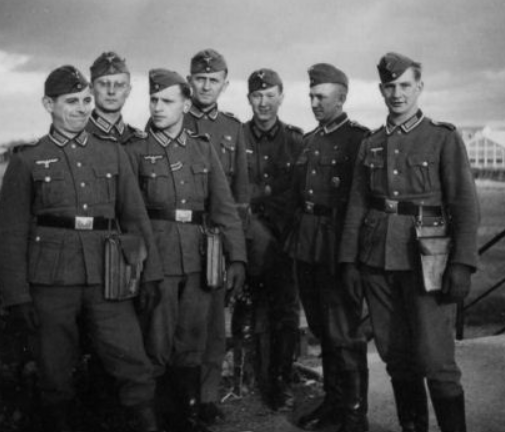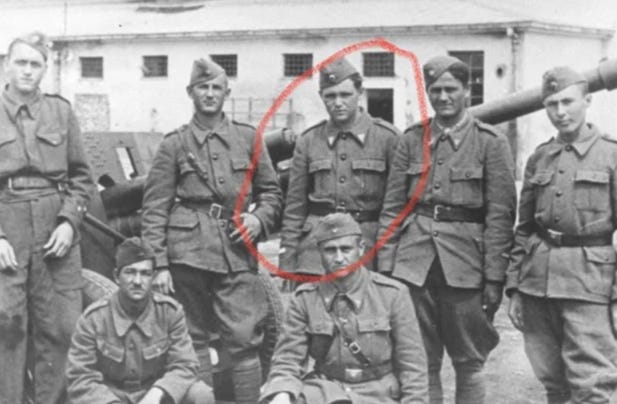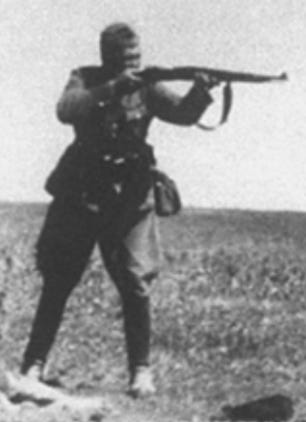The Ivanhorod Einsatzgruppen Photograph is possibly one of the most iconic photographs in history and certainly one of the most commonly reproduced ones about the Second World War especially in reference to the so-called ‘Holocaust’ because it appears to show a German soldier – claimed to be a member of an Einsatzgruppe – in the process of shooting a jewish woman as part of the ‘Holocaust’ in – or near – the Ukrainian village of Ivanhorod in 1942.
Now while I’ve already touched on the Ivanhorod Einsatzgruppen Photograph in reference to the reply of German photograph expert and Professor of Medicine Walter Croy in the ‘Deutsche Soldaten Zeitung’ of 26th January 1962 after it was first published in 1959 and prominent British journalist Robert Fisk’s desperate attempts to pooh-pooh the problems with the photograph not being a fake in 2011. (1)
Given that this photograph continues to be widely used it is important to go through what it is claimed to be and what the evidence actually suggests it is as well as why.
To begin with the Ivanhorod Einsatzgruppen Photograph is normally presented without qualification in cropped not full form.
This usually takes the form of the following cropped versions:
This however is the uncropped version, and we can already that the cropped versions deliberately remove a lot of contextual information from the photograph, but also completely changes the photograph’s meaning to the viewer:
Now the sharp-eyed among you will have already noticed there are a lot of problems with the full photograph which are hidden better in the cropped versions, but for the less sharp-eyed let’s go through them shall we?
Let’s begin!
A) The Uniform of the Soldier.
Now to the casual observer the soldier who is fully shown in the image; the soldier sort of looks like a German soldier of the period but to anyone with a better understanding of the uniforms of the period. You will notice that if the soldier is German than his uniform is wrong, because you see he is wearing jodhpurs (cavalry trousers) which you can see from the flared part of the top and were only worn by German officers not by NCOs or private soldier, but the rest of the uniform – if it is German – is that of an NCO or private soldier.
This means we cannot be looking at a German soldier here because the top of the uniform does not match the bottom half of the uniform, but nor is it a Soviet soldier because Soviet uniforms of the era simply don’t look like that.
However, we know of one military of the time that was involved in the Second World War which was the Royal Yugoslavian Army that was dissolved by the Germans in early 1941, but which continued fighting as partisans for - and against 0 the Germans dependent on the group of soldiers concerned.
For the record this is what German NCOs and private soldiers of the time looked like (note the lack of jodhpurs and that the [thinner] caps look different to the one the photograph):
And this is what Royal Yugoslavian Army of the time looked like (note the jodhpurs on NCOs/private soldiers and the broader/thicker cap while their top uniform looks similar to the German Wehrmacht):
Now from this we can clearly see that the soldier in the Ivanhorod Einsatzgruppen Photograph is not wearing a German uniform at all, but rather one that matches the type worn by the Royal Yugoslavian Army.
B) The Rifle being used by the Soldier.
Now this might seem arcane to many but the rifle being used by the soldier in the Ivanhorod Einsatzgruppen Photograph is also problem because while is sort of looks like a standard issue German Karabiner 98k rifle that was widely used by both German regular forces and the Einsatzgruppe. If you look at the detail of the rifle itself, you’ll notice that it isn’t actually a German rifle at all but rather a Yugoslavian M24 series rifle which was based on the German Mauser as it happens.
For clarity this is a close up of the soldier in the photograph:
This is the German Karabiner 98k (note that compared to the photo there is no second dip on the top and the bolt-loading mechanism isn’t sticking out in the photo plus the large end sight is the wrong shape and too big):
This by contrast is the original Yugoslavian M24 that the Royal Yugoslavian Army were using widely before and during the Second World War:
While this is the Yugoslavian M24/47 – first produced in 1947 – which let us note has the right profile of the rifle in the photo as well as the all-important large sight which is significantly different then original M24 above and seems to me to be the best match to the rifle in the Ivanhorod Einsatzgruppen Photograph:
Now based on the above we can see that the likeliest candidate for the rifle in the photo is actually the Yugoslavian M24/47 that was first produced in 1947, which would date the Ivanhorod Einsatzgruppen Photograph to after 1947 and means that it cannot possibly show German soldiers in Ivanhorod in the Ukraine in 1942.
The only possible counter-argument to this identification is the cleaning rod – the tiny rod just below the barrel in both the Yugoslavian M24 and M24/47 but which is more covered and less obvious in the Karabiner 98k - and the claim that it ‘isn’t there’, but having looked closely at the area on the photograph it looks like it actually is present in a tiny parallel line just below the barrel but as it is rather thin it is hard to see.
Even if it were not there that wouldn’t be an argument against the identification of the rifle in the photo with the Yugoslavian M24 and M24/47 and not the Karabiner 98k given that it could have been removed/dropped/lost for some reason or another that we are unaware of and the other features of the rifle are clearly those of the Yugoslavian M24/47 not the Karabiner 98k.
Thus, we can see that the Ivanhorod Einsatzgruppen Photograph must come from 1947 at the earliest and cannot come from 1942.
C) What is going on in the Ivanhorod Einsatzgruppen Photograph.
Now clearly when we look at the original photo not the cropped version, we can see that we've got civilians - who look like they could be a family including women, children and quite possibly older individuals - in a field who possibly have been doing agricultural work (hence the spade but no observable ditch/grave although that hasn’t stopped writers imaging one into existence!).
Where we've got three men with rifles - one fully visible - but the two rifles on the left are shooting over the group of civilians to the right who aren't 'falling to the ground’ but are rather bending their knees like they are taking cover by dropping to their knees/bending over so they can get on the ground without hurting themselves. This we can see from the rather awkward positions the civilians in the photo are in relative to the ground that are only explicable if they are taking cover by flattening themselves on the ground not falling to the ground after being shot.
Further we have the fully visible soldier with the rifle who - if you trace the barrel direction - is shooting past - not at - the woman clutching the child and running towards the group bending down to take cover, which – sheltering with your family - is a natural reaction in times of danger.
The woman who looks like she has been shot on the left of the image is likely the reason why the rest of the people in the photo are taking cover/running for cover/taking aim/shooting because she's been hit – and probably killed - and we see the moment of everyone reacting to this situation that has been inadvertently caught here.
D) The Light and Shadow in the Ivanhorod Einsatzgruppen Photograph.
There are technical problems with the photograph as you'll note the large patch of shadow on the left is being cast by something - apparently the dead woman on the ground - but yet the soldier, woman/child taking cover and the group of people do not cast similar shadows, which suggests the photo has been subjected to photographic alteration of some kind since the light and shadow do not correspond nor make sense.
However, on this I can no better than to quote Otto Corey’s analysis from 1962 (my translation from the German):
‘From the light and shadow formation it can be seen that the photo was taken in the sun, with the sun halfway up to the right behind the camera. The highlights are on the right, while the shadows are a little deeper in the background on the left. The woman with the child would have to cast a corresponding shadow behind her to the left. The same would have to apply to the soldier. So, something seems wrong here. The other lighting applies to the soldier himself. The light and shadow here suggest that the sun is at a higher position, with the sun shining more sharply to the right. The soldier's right leg would normally also have been hit by the sun's rays but is not in the photo.
The picture is therefore not free from retouching. The background line between the soldier and the woman is sprayed with grey paint, as is the background on the left and right edges of the picture. Apparently, the area of the woman's back was resprayed, as was her hair. Manual retouching is noticeable on the child's head and on the soldier’s rifle.’ (2)
For the reader’s assistance I reproduce the uncropped photo to allow them to see what Cory is referring to:
Thus, we can see that the Ivanhorod Einsatzgruppen Photograph has likely been subjected to photographic editing and thus is actually a photographic fraud of some kind.
E) The Providence of the Photograph.
This is poor in the extreme. Despite being presented as a 'definitive photograph' the photo in fact comes from the Polish resistance and was allegedly intercepted – presumably in 1942 - by a teenage ‘Polish resistance member’ named Jerzy Tomaszewski who worked in the central Warsaw Post Office and also was part of an underground photograph lab called ‘Foto-Rys’ with the photo being labelled ‘Ukraine 1942, Judenaktion, Iwangorod’ (lit. ‘Ukraine 1942, Jewish Action, Ivanhorod’) that he claimed to have sent a copy of to the Polish Government-in-Exile in London but the kept the original himself. (3)
The problem is - of course - that there is no evidence other than Tomaszewski’s anecdotal claims that he sent this a copy of photo to the Polish Government-in-Exile in London sometime between 1942 and 1943 as no one has ever – to my knowledge – found the copy he allegedly sent in the wartime files of the Polish Government-in-Exile or even in the Allied propaganda bureaus who would have had an interest in exploiting.
Instead, the first publication of the Ivanhorod Einsatzgruppen Photograph occurs not during the Second World War, but rather in an official pro-Communist book documenting the ‘atrocities of the Third Reich’ on behalf of the Polish communist veteran’s association ‘Zwiazek Bojownikow o Wolnosc i Demokracje’ (lit. ‘Society of Fighters for Freedom and Democracy’) of which Tomaszewski was the co-editor (meaning in short he was a communist party member – or at least deemed political reliable by such - at the time) in 1959, which Tomaszewski has long sought to downplay because it suggests that it might actually be post-war manufactured communist atrocity propaganda. (4)
Since then, Tomaszewski has never allowed anyone to critically examine the original – the most he has done is show them it (as with Janina Struk) – (5) which is likely because… well… it is actually a fake photograph created by Tomaszewski betweeen 1947 and 1959 using tried and tested photographic techniques given that the soldier in the Ivanhorod Einsatzgruppen Photograph is wearing a Royal Yugoslavian Army uniform, using a post-war Yugoslavian rifle the M24/47 and the photograph has clearly been edited in someway due to the inconsistent light and shadow in it.
Thus in truth the Ivanhorod Einsatzgruppen Photograph is simply a post-war Polish communist created fraud and does not show German Einsatzgruppen personnel ‘shooting jews in Ivanhorod in 1942’.
References
(1) See my article: https://karlradl14.substack.com/p/an-english-translation-of-professor
(2) Ibid.
(3) Janina Struk, 2020, [2011], ‘Private Pictures: Soldiers' Inside View of War’, 1st Edition, Routledge: New York, pp. 78-81
(4) Ibid., p. 86
(5) For example, see: https://www.independent.co.uk/voices/commentators/fisk/robert-fisk-ukraine-1942-what-are-we-seeing-6264646.html















Carlo Mattogno's book, The Einzatsgruppen in the Occupied Eastern Territories: Genesis, Missions and Actions, is a staggering read. Mattogno surely must be an autist to do what he does, how he does. It's supernatural.
It is also heartbreaking that The Einzatsgruppen have been so demonised, when their main task was to restore order, which they executed with integrity.
Excellent article. Thank you.
I used to be a photographer, shooting film and printing in the darkroom and this looks "wrong" somehow, though expertly done.
I am still impressed by the level of manipulation that they could achieve on real film and paper though.
There is a book by Carlos Whitlock Porter, called "Made in Russia: The Holocaust, where he dismantles many of the propaganda photos of the time and shows how the original looked.